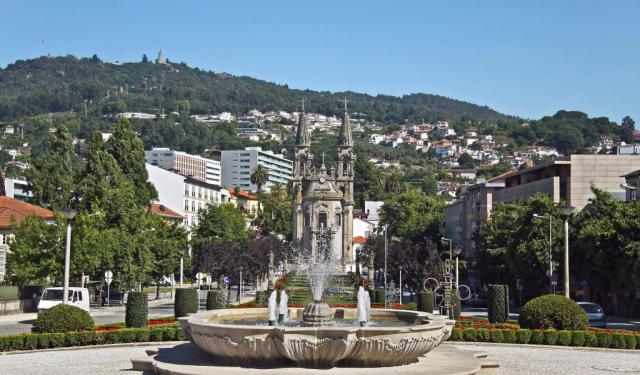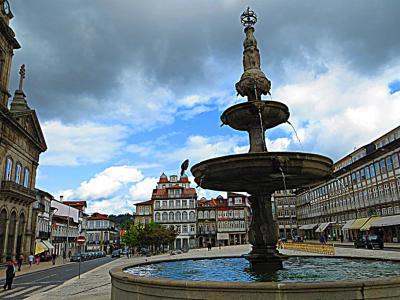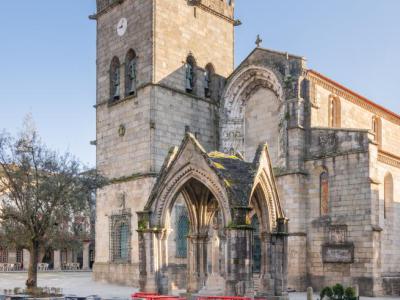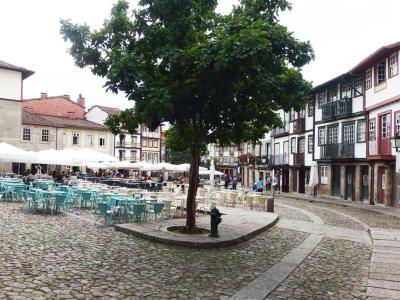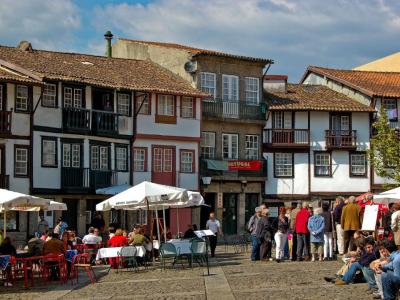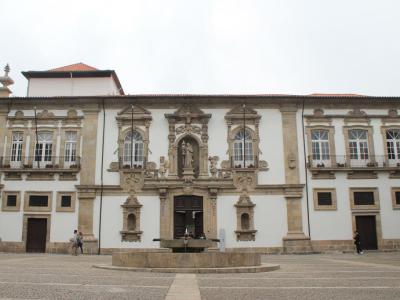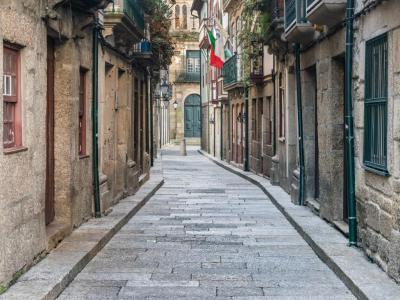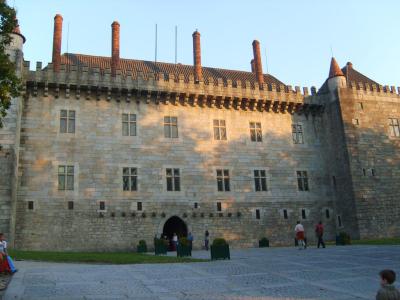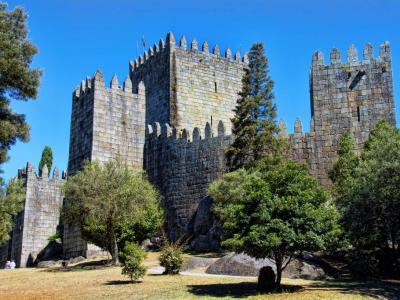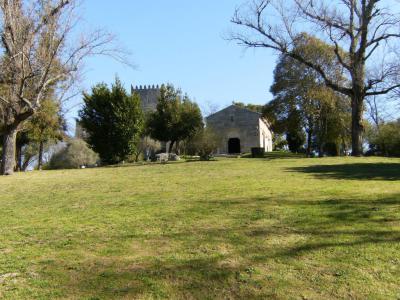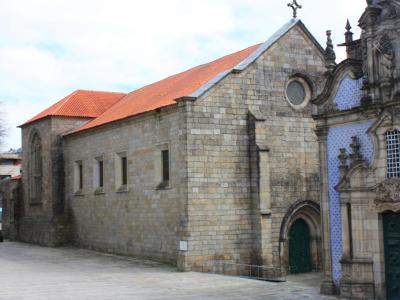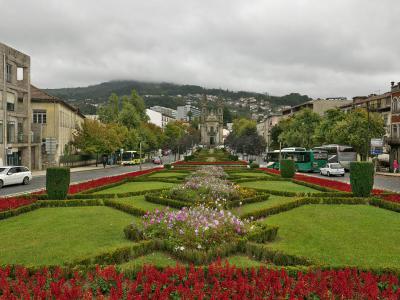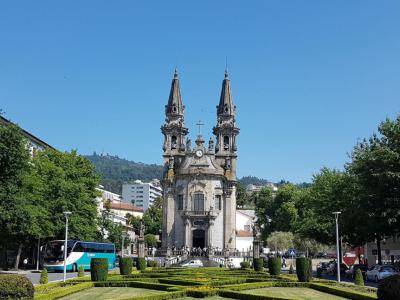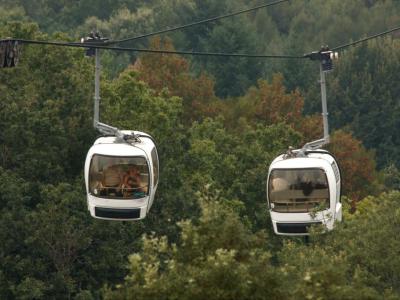Guimaraes Introduction Walking Tour (Self Guided), Guimaraes
Guimarães, the capital of the industrious Ave region of Portugal, is one of the country's most beautiful and authentic cities. Because of its pivotal role in the nation's history, Guimarães also holds the esteemed title of the "birthplace of Portugal" or "the cradle city". The latter, in part, is due to the first King of Portugal, Afonso Henriques, being born here in 1106 (or was it in 1109 or 1111?).
Anyway, the city itself was founded in the 9th century AD as Vimaranes, possibly named after the warrior Vímara Peres, who made it the seat of power for the County of Portugal which he had conquered for the Kingdom of Galicia. In 1128, the Battle of São Mamede fought nearby marked a turning point toward Portugal's independence.
At the turn of the 14th century, Guimarães saw expansion and fortification with the construction of defensive walls, which were dismantled over a hundred years later to unite the uptown and downtown areas. The city's architectural landscape evolved gradually, with notable additions like Saint Peter's Basilica completed in the late 1800s.
In the 19th century, urbanization efforts transformed Guimarães, leading to the demolition of city walls and the creation of new streets and avenues while preserving its historical core. This preservation earned Guimarães recognition – its downtown area was designated as a UNESCO World Heritage site in 2001.
One of the central hubs of the city is the renowned Toural Square (Largo do Toural), a bustling meeting point teeming with energy since the 17th century.
The medieval charm of Saint Mary Street (Rua de Santa Maria), adorned with architectural marvels such as the Convent of Santa Clara, leads travelers to the majestic Palace of the Dukes of Bragança (Paço dos Duques de Bragança).
Perched atop a hill, the imposing Guimaraes Castle (Castelo de Guimarães) overlooks the city, believed being the birthplace of Portugal's first king.
For a unique perspective of the cityscape, visitors can ascend the Penha Cable Car (Teleférico de Penha), providing panoramic views of Guimarães and its environs.
For travelers with a penchant for discovery – and let's admit, isn't that most of us? – exploring Guimarães is an absolute must, especially if interested in the origin of Portugal. With no shortage of things to do and see here, you can easily lose yourself in the charms of this city for several days. However, if you want to see all its key attractions in one day, follow this self-guided tour!
Anyway, the city itself was founded in the 9th century AD as Vimaranes, possibly named after the warrior Vímara Peres, who made it the seat of power for the County of Portugal which he had conquered for the Kingdom of Galicia. In 1128, the Battle of São Mamede fought nearby marked a turning point toward Portugal's independence.
At the turn of the 14th century, Guimarães saw expansion and fortification with the construction of defensive walls, which were dismantled over a hundred years later to unite the uptown and downtown areas. The city's architectural landscape evolved gradually, with notable additions like Saint Peter's Basilica completed in the late 1800s.
In the 19th century, urbanization efforts transformed Guimarães, leading to the demolition of city walls and the creation of new streets and avenues while preserving its historical core. This preservation earned Guimarães recognition – its downtown area was designated as a UNESCO World Heritage site in 2001.
One of the central hubs of the city is the renowned Toural Square (Largo do Toural), a bustling meeting point teeming with energy since the 17th century.
The medieval charm of Saint Mary Street (Rua de Santa Maria), adorned with architectural marvels such as the Convent of Santa Clara, leads travelers to the majestic Palace of the Dukes of Bragança (Paço dos Duques de Bragança).
Perched atop a hill, the imposing Guimaraes Castle (Castelo de Guimarães) overlooks the city, believed being the birthplace of Portugal's first king.
For a unique perspective of the cityscape, visitors can ascend the Penha Cable Car (Teleférico de Penha), providing panoramic views of Guimarães and its environs.
For travelers with a penchant for discovery – and let's admit, isn't that most of us? – exploring Guimarães is an absolute must, especially if interested in the origin of Portugal. With no shortage of things to do and see here, you can easily lose yourself in the charms of this city for several days. However, if you want to see all its key attractions in one day, follow this self-guided tour!
How it works: Download the app "GPSmyCity: Walks in 1K+ Cities" from Apple App Store or Google Play Store to your mobile phone or tablet. The app turns your mobile device into a personal tour guide and its built-in GPS navigation functions guide you from one tour stop to next. The app works offline, so no data plan is needed when traveling abroad.
Guimaraes Introduction Walking Tour Map
Guide Name: Guimaraes Introduction Walking Tour
Guide Location: Portugal » Guimaraes (See other walking tours in Guimaraes)
Guide Type: Self-guided Walking Tour (Sightseeing)
# of Attractions: 13
Tour Duration: 2 Hour(s)
Travel Distance: 2.8 Km or 1.7 Miles
Author: DanaOffice
Sight(s) Featured in This Guide:
Guide Location: Portugal » Guimaraes (See other walking tours in Guimaraes)
Guide Type: Self-guided Walking Tour (Sightseeing)
# of Attractions: 13
Tour Duration: 2 Hour(s)
Travel Distance: 2.8 Km or 1.7 Miles
Author: DanaOffice
Sight(s) Featured in This Guide:
- Largo do Toural (Toural Square)
- Igreja de Nossa Senhora da Oliveira (Church of Our Lady of Oliveira)
- Largo da Oliveira (Olive Tree Square)
- Praca de Sao Tiago (Saint James Square)
- Convent of Saint Clare and Guimaraes City Hall
- Rua de Santa Maria (Saint Mary Street)
- Paco dos Duques de Braganca (Palace of the Dukes of Braganca)
- Castelo de Guimaraes (Castle of Guimaraes)
- Parque do Castelo (Castle Park)
- Igreja e Convento de Sao Francisco (Church and Convent of Saint Francis)
- Largo Republica do Brasil (Republic of Brazil Square)
- Church of Our Lady of Consolation and Holy Steps
- Teleferico de Penha (Penha Cable Car)
1) Largo do Toural (Toural Square) (must see)
Toural Square stands as the focal point and heart of Guimarães. The historical significance of this square can be traced back to the 17th century when it served as a venue for cattle fairs and bullfights. Located adjacent to the main City Gate and initially outside the city walls, the square derived its name from these early events.
In the 18th century, Queen D. Maria I played a pivotal role in shaping the square's transformation. The old wall on the east side was demolished at her command, making way for the construction of uniform houses characterized by Pombaline architecture. This marked a turning point, as commercial spaces were integrated into the square's landscape.
During this period, the creation of the Public Garden, surrounded by an ornate iron fence, added a touch of greenery to Toural. In 1878, the garden opened to the public, becoming a central feature of the square. As the 19th century unfolded, Toural solidified its status as one of Guimaraes' most important squares, attracting locals and serving as a popular meeting place.
With the establishment of the Republic in 1910, the Public Garden underwent relocation to another site, and Toural underwent further changes. The statue of D. Afonso Henriques, originally placed in the square, was moved closer to the Castle. In its stead, an eye-catching artistic fountain adorned the square, adding a new dimension to its ambiance.
In the 18th century, Queen D. Maria I played a pivotal role in shaping the square's transformation. The old wall on the east side was demolished at her command, making way for the construction of uniform houses characterized by Pombaline architecture. This marked a turning point, as commercial spaces were integrated into the square's landscape.
During this period, the creation of the Public Garden, surrounded by an ornate iron fence, added a touch of greenery to Toural. In 1878, the garden opened to the public, becoming a central feature of the square. As the 19th century unfolded, Toural solidified its status as one of Guimaraes' most important squares, attracting locals and serving as a popular meeting place.
With the establishment of the Republic in 1910, the Public Garden underwent relocation to another site, and Toural underwent further changes. The statue of D. Afonso Henriques, originally placed in the square, was moved closer to the Castle. In its stead, an eye-catching artistic fountain adorned the square, adding a new dimension to its ambiance.
2) Igreja de Nossa Senhora da Oliveira (Church of Our Lady of Oliveira)
The Church of Our Lady of Oliveira holds a storied history dating back to the establishment of the city by Countess Mumadona Dias. Founded in the 10th century, the initial monastery, dedicated to the Savior of the World, the Virgin Mary, and the Holy Apostles, evolved into a collegiate body in the 12th century.
To safeguard the monastery, an early fortification predating the present Guimaraes Castle was erected. The original construction, presumed to bear typical Benedictine iconography depicting themes of Good and Evil, has left scant remnants. However, a Romanesque capital from the latter half of the 12th century, originally part of the church's main portal, is preserved and housed in the Alberto Sampaio Museum.
Throughout the Middle Ages, the Church of Our Lady of Oliveira gained prominence as a significant religious center on the Iberian Peninsula. Pilgrims traveling to Santiago de Compostela contributed to its popularity, making it a revered destination. However, with the establishment of the republic in 1911, the collegiate body was dissolved.
The church has undergone several reconstructions over the centuries, resulting in a blend of architectural styles from different eras. The most recent intervention in 1967 sought to restore much of the Gothic influence that still characterizes the church today. This effort followed a neoclassical renovation in 1830.
To safeguard the monastery, an early fortification predating the present Guimaraes Castle was erected. The original construction, presumed to bear typical Benedictine iconography depicting themes of Good and Evil, has left scant remnants. However, a Romanesque capital from the latter half of the 12th century, originally part of the church's main portal, is preserved and housed in the Alberto Sampaio Museum.
Throughout the Middle Ages, the Church of Our Lady of Oliveira gained prominence as a significant religious center on the Iberian Peninsula. Pilgrims traveling to Santiago de Compostela contributed to its popularity, making it a revered destination. However, with the establishment of the republic in 1911, the collegiate body was dissolved.
The church has undergone several reconstructions over the centuries, resulting in a blend of architectural styles from different eras. The most recent intervention in 1967 sought to restore much of the Gothic influence that still characterizes the church today. This effort followed a neoclassical renovation in 1830.
3) Largo da Oliveira (Olive Tree Square)
Olive Tree Square, named after a centuries-old olive tree planted on the same spot, is surrounded by charming houses typical of northern Portugal. This square serves as an excellent starting point for exploring the city's streets.
Alongside its picturesque setting, Olive Tree Square features notable attractions. On the eastern side, a fascinating Gothic shrine was constructed during the reign of D. Afonso IV to commemorate the Battle of Salado in 1340. This battle saw Portuguese and Castilian forces join together to defeat the Moorish army from Granada.
The square is one of two main adjoining squares in the old town, boasting an array of impressive buildings. Cafés and restaurants abound, making Largo da Oliveira a vibrant hub for the city's social scene.
Alongside its picturesque setting, Olive Tree Square features notable attractions. On the eastern side, a fascinating Gothic shrine was constructed during the reign of D. Afonso IV to commemorate the Battle of Salado in 1340. This battle saw Portuguese and Castilian forces join together to defeat the Moorish army from Granada.
The square is one of two main adjoining squares in the old town, boasting an array of impressive buildings. Cafés and restaurants abound, making Largo da Oliveira a vibrant hub for the city's social scene.
4) Praca de Sao Tiago (Saint James Square)
Saint James Square holds a special place in Guimaraes as it is steeped in tradition and historical significance. According to local lore, the apostle S. Tiago brought an image of the Virgin Saint Mary to Guimaraes, where it was housed in a pagan temple within the square, eventually giving rise to its name. The square's medieval layout has been well-preserved, and it has been mentioned in various documents throughout history.
Saint James Square exudes medieval charm, featuring rehabilitated facades adorned with colorful flower boxes and traditional clothing hung out to dry. The architectural splendor of 17th and 18th-century houses, meticulously restored by the Guimaraes City Council, captivates visitors. Adjacent to Olive Tree Square, this square forms a social hub in the old town, offering a delightful collection of historic buildings.
Immersing visitors in a genuine medieval atmosphere, Saint James Square is rich in history and architectural allure. Despite the buildings' apparent age, the square's charm lies in the well-maintained structures that exude character and authenticity. The square is not only a historical focal point but also a vibrant space to enjoy a leisurely stroll, a delicious meal, or a refreshing drink at one of the many charming cafes that line its perimeter.
Saint James Square exudes medieval charm, featuring rehabilitated facades adorned with colorful flower boxes and traditional clothing hung out to dry. The architectural splendor of 17th and 18th-century houses, meticulously restored by the Guimaraes City Council, captivates visitors. Adjacent to Olive Tree Square, this square forms a social hub in the old town, offering a delightful collection of historic buildings.
Immersing visitors in a genuine medieval atmosphere, Saint James Square is rich in history and architectural allure. Despite the buildings' apparent age, the square's charm lies in the well-maintained structures that exude character and authenticity. The square is not only a historical focal point but also a vibrant space to enjoy a leisurely stroll, a delicious meal, or a refreshing drink at one of the many charming cafes that line its perimeter.
5) Convent of Saint Clare and Guimaraes City Hall
Built in 1548, the Convent of Saint Clare holds centuries of history within its walls. It served as a religious retreat for nuns from 1562 until 1891, when the last nun passed away. The convent witnessed the quiet devotion of its occupants for nearly three centuries.
The Convent of St. Clare boasts a Baroque-style façade that captivates visitors with its intricate details carved in granite. The façade is adorned with superb craftsmanship, leading the eye to the central focal point-the sculpture of Santa Clara. The Baroque aesthetics are evident in the ornate embellishments that contribute to the overall grandeur of the structure.
Inside the former convent, visitors can explore beautiful cloisters and gardens. These hidden gems offer a serene and contemplative atmosphere, allowing visitors to connect with the peaceful legacy of the nuns who once inhabited the convent. The architecture and landscaping create an immersive experience that transports visitors back in time.
In 1968, recognizing the historical and architectural value of the site, the convent was repurposed as the City Hall of Guimaraes. Today, the City Hall not only conducts municipal affairs but also houses the municipal archives.
The City Hall welcomes visitors during working hours, offering free entrance to those interested in exploring its historical and administrative aspects. The experience allows visitors to appreciate the convergence of history, art, and governance within the walls of this unique establishment.
The Convent of St. Clare boasts a Baroque-style façade that captivates visitors with its intricate details carved in granite. The façade is adorned with superb craftsmanship, leading the eye to the central focal point-the sculpture of Santa Clara. The Baroque aesthetics are evident in the ornate embellishments that contribute to the overall grandeur of the structure.
Inside the former convent, visitors can explore beautiful cloisters and gardens. These hidden gems offer a serene and contemplative atmosphere, allowing visitors to connect with the peaceful legacy of the nuns who once inhabited the convent. The architecture and landscaping create an immersive experience that transports visitors back in time.
In 1968, recognizing the historical and architectural value of the site, the convent was repurposed as the City Hall of Guimaraes. Today, the City Hall not only conducts municipal affairs but also houses the municipal archives.
The City Hall welcomes visitors during working hours, offering free entrance to those interested in exploring its historical and administrative aspects. The experience allows visitors to appreciate the convergence of history, art, and governance within the walls of this unique establishment.
6) Rua de Santa Maria (Saint Mary Street)
Steeped in history, Saint Mary Street holds the distinction of being one of the first streets laid out in Guimarães. Its purpose was clear – to serve as a vital link between the convent founded by Mumadona, nestled in the lower part of the town, and the regal Castle perched atop the upper town. Dating back to the 17th century, the street has retained its name through the ages, becoming an integral part of the city's identity.
The cobbled path of Rua de Santa Maria is adorned with architectural masterpieces that echo the sophistication of the 15th and 16th centuries. These structures, once the residences of Guimaraes' nobility and affluent families, stand as living testaments to the city's cultural and artistic prowess during that era. Notable landmarks along this historic route include the Casa do Arco, Casa dos Peixotos, the Gothic Casa dos Valadares, and the Convent of Santa Clara.
The Casa do Arco, with its arch-shaped entrance, and the Casa dos Valadares, an exemplar of Gothic architecture, showcase the city's commitment to preserving its cultural treasures. The Convent of Santa Clara, standing proudly as one of Guimaraes' richest convents, adds a spiritual dimension to this historic promenade.
The cobbled path of Rua de Santa Maria is adorned with architectural masterpieces that echo the sophistication of the 15th and 16th centuries. These structures, once the residences of Guimaraes' nobility and affluent families, stand as living testaments to the city's cultural and artistic prowess during that era. Notable landmarks along this historic route include the Casa do Arco, Casa dos Peixotos, the Gothic Casa dos Valadares, and the Convent of Santa Clara.
The Casa do Arco, with its arch-shaped entrance, and the Casa dos Valadares, an exemplar of Gothic architecture, showcase the city's commitment to preserving its cultural treasures. The Convent of Santa Clara, standing proudly as one of Guimaraes' richest convents, adds a spiritual dimension to this historic promenade.
7) Paco dos Duques de Braganca (Palace of the Dukes of Braganca) (must see)
Steeped in history, the Palace of the Dukes of Braganca serves as a tangible link to Portugal's regal past. Constructed in the 15th century, the palace was commissioned by D. Afonso, the 1st Duke of the House of Bragança and the 8th Count of Barcelos. D. Afonso, an illegitimate son of King D. João I and D. Inês Pires Esteves, undertook the building of this noble residence during his second marriage to D. Constança de Noronha. D. Constança, the daughter of D. Afonso, Count of Gijón and Noronha, and D. Isabel, Lady of Viseu, added a touch of regal splendor to the palace's lineage.
During the 15th century, the palace thrived as a hub of aristocratic life. However, with the passage of centuries, it faced progressive abandonment and subsequent decay due to various factors. The once-majestic structure witnessed a gradual decline, succumbing to the ravages of time.
In a remarkable feat of architectural revitalization, the palace experienced a renaissance between 1937 and 1959. Architect Rogério de Azevedo spearheaded an extensive and intricate reconstruction project, breathing new life into the historic edifice. Today, the Palace of the Dukes of Braganca, serves as both a museum and a cultural sanctuary, offering insights into the opulence of bygone eras. The palace's storied past unfolds in each room, allowing guests to appreciate the architectural finesse and historical significance that define this cultural landmark.
During the 15th century, the palace thrived as a hub of aristocratic life. However, with the passage of centuries, it faced progressive abandonment and subsequent decay due to various factors. The once-majestic structure witnessed a gradual decline, succumbing to the ravages of time.
In a remarkable feat of architectural revitalization, the palace experienced a renaissance between 1937 and 1959. Architect Rogério de Azevedo spearheaded an extensive and intricate reconstruction project, breathing new life into the historic edifice. Today, the Palace of the Dukes of Braganca, serves as both a museum and a cultural sanctuary, offering insights into the opulence of bygone eras. The palace's storied past unfolds in each room, allowing guests to appreciate the architectural finesse and historical significance that define this cultural landmark.
8) Castelo de Guimaraes (Castle of Guimaraes) (must see)
The Castle of Guimaraes, standing proudly atop the Broad Hill, serves as an emblematic testament to the rich tapestry of legend, poetry, and heroism that envelops the early chapters of Portuguese history. In the annals of circa 968, Mumadona, the Countess of Galicia, commissioned the construction of a castle on this strategic site. The motivation behind this endeavor was to provide refuge for the local population against the relentless onslaughts by Viking marauders from the north and Muslim invaders launching raids from the territories they occupied to the south.
The turning point in the castle's history occurred when Count Henry, assuming the governance of the province known as Portucalense from his father-in-law, Alfonso VI of León, ordered the construction of a more substantial and fortified structure. This marked the inception of the formidable defensive complex that stands today.
The castle is dominated by a square keep that stands proudly between four towers, each steadfastly guarding a corner of the fortress walls. The architectural prowess of this medieval stronghold is evident in its robust construction and strategic layout, showcasing the military acumen of its builders.
While not explicitly documented, it is widely believed that the building nestled against the inner part of the northern wall served as the residence of Count Henry. This site is speculated to be the birthplace of his son, Afonso Henriques, who went on to become the first King of Portugal.
The turning point in the castle's history occurred when Count Henry, assuming the governance of the province known as Portucalense from his father-in-law, Alfonso VI of León, ordered the construction of a more substantial and fortified structure. This marked the inception of the formidable defensive complex that stands today.
The castle is dominated by a square keep that stands proudly between four towers, each steadfastly guarding a corner of the fortress walls. The architectural prowess of this medieval stronghold is evident in its robust construction and strategic layout, showcasing the military acumen of its builders.
While not explicitly documented, it is widely believed that the building nestled against the inner part of the northern wall served as the residence of Count Henry. This site is speculated to be the birthplace of his son, Afonso Henriques, who went on to become the first King of Portugal.
9) Parque do Castelo (Castle Park)
The Castle Park unfolds with an irregular plan, offering free access to locals and visitors alike. The park's central axis, oriented from the castle to the Church of Saint Damasus in the northeast, encompasses significant landmarks. The rectangular yard crowns the highest point near the castle, while prominent structures line the route. The main facade of the Church of Saint Damasus graces the top of this yard, creating a visual spectacle. Notable monuments like the Palace of the Dukes of Braganca, Holy Cross Chapel, and the Church of Saint Michael of the Castle contribute to the historical tapestry along this path.
The park's total perimeter of approximately 1600 meters is bordered by streets, creating a sense of seclusion amid the urban hustle. Granite support walls, varying in height from 0.90m to around 4m, elegantly negotiate the high slope between the castle and the Chapel of Santa Cruz. A notable feature is a 3.5m thick and 148m long wall outside the castle, adding architectural allure and defining pathways.
The park's total perimeter of approximately 1600 meters is bordered by streets, creating a sense of seclusion amid the urban hustle. Granite support walls, varying in height from 0.90m to around 4m, elegantly negotiate the high slope between the castle and the Chapel of Santa Cruz. A notable feature is a 3.5m thick and 148m long wall outside the castle, adding architectural allure and defining pathways.
10) Igreja e Convento de Sao Francisco (Church and Convent of Saint Francis)
The Church and Convent of Saint Francis holds a rich history dating back to its initial construction when it stood beside the medieval wall. In 1325, D. Dinis ordered its demolition, a decision that was later reversed by King D. João I, who authorized its reconstruction on the present site, a process spanning 75 years.
The church's interior reflects the stylistic influences of the extensive renovations carried out in the 18th century. The Baroque transformation adorned the once modest Franciscan temple with a wealth of carvings and tiles. Following the dissolution of religious orders in 1834, the church was handed over to the Third Order of Saint Francis.
A notable feature is the chapel housing the remains of S. Gualter, one of the pioneering Franciscans and evangelists in the region. The interior is adorned with an array of artistic treasures, including sculptures, paintings, carvings, and sacred art. Renowned artists such as Soares dos Reis, Giuseppi Berardi, and Roquemont have contributed to the church's artistic legacy. A visit to the sacristy is highly recommended to admire an Italian Renaissance-style marble table with intricate and colorful inlays.
The church's interior reflects the stylistic influences of the extensive renovations carried out in the 18th century. The Baroque transformation adorned the once modest Franciscan temple with a wealth of carvings and tiles. Following the dissolution of religious orders in 1834, the church was handed over to the Third Order of Saint Francis.
A notable feature is the chapel housing the remains of S. Gualter, one of the pioneering Franciscans and evangelists in the region. The interior is adorned with an array of artistic treasures, including sculptures, paintings, carvings, and sacred art. Renowned artists such as Soares dos Reis, Giuseppi Berardi, and Roquemont have contributed to the church's artistic legacy. A visit to the sacristy is highly recommended to admire an Italian Renaissance-style marble table with intricate and colorful inlays.
11) Largo Republica do Brasil (Republic of Brazil Square)
Historically, Republic of Brazil Square, commonly known as the Market Square, served as a bustling market ground, hosting a large market every Saturday. This market was considered one of the kingdom's most significant weekly events, offering a diverse array of goods, including poultry, cereals, fruits, crockery, glassware, fabrics (wool, silk, linen, cotton), and ironworks. Livestock exhibitions and sales also took place, making the Market Square a hub of commercial activity.
During the mid-19th century, the Market Square became a pivotal location for commerce, and in 1854, it was officially designated as the permanent venue for the Pig Fair and the Cattle Fair. Over time, the square evolved, and in the late 20th century, a beautiful garden with a fountain and rotunda was inaugurated at its northern end. This garden features a central display of vibrant flowers and shrubs, creating a picturesque setting that changes with the seasons.
At the northern edge of the garden stands a fountain within the rotunda, offering a refreshing and visually appealing focal point. The garden extends southward to the church, showcasing a dynamic array of seasonal flowers. The panoramic view from the square includes the Penha Mountain, and nearby, visitors can find the Cable Car, providing access to the mountain's summit for a panoramic perspective of the surroundings.
During the mid-19th century, the Market Square became a pivotal location for commerce, and in 1854, it was officially designated as the permanent venue for the Pig Fair and the Cattle Fair. Over time, the square evolved, and in the late 20th century, a beautiful garden with a fountain and rotunda was inaugurated at its northern end. This garden features a central display of vibrant flowers and shrubs, creating a picturesque setting that changes with the seasons.
At the northern edge of the garden stands a fountain within the rotunda, offering a refreshing and visually appealing focal point. The garden extends southward to the church, showcasing a dynamic array of seasonal flowers. The panoramic view from the square includes the Penha Mountain, and nearby, visitors can find the Cable Car, providing access to the mountain's summit for a panoramic perspective of the surroundings.
12) Church of Our Lady of Consolation and Holy Steps
The Church of Our Lady of Consolation, along with the Holy Steps, stands as a splendid example of Baroque religious architecture in Guimaraes. Commenced in 1769, this church is believed to be the final creation of André Soares (1720-1769), a prominent architect of the Baroque era. The church exhibits a typical Baroque style scenography characterized by dynamic towers, a gracefully curved main facade, sinuous lines of the principal staircase, and sculptures strategically placed next to the facade.
Architecturally, the church follows a longitudinal plan, featuring a single nave with concave angles and a chancel. The present staircase, dating back to the mid-19th century, adds to the grandeur of the structure. With ornate balustrades and sculptures, the staircase creates a striking scenographic effect, enhancing the overall visual appeal of the church.
Upon entering the church, one is captivated by the masterfully crafted altarpiece and tribune, designed by the skilled carver José António da Cunha. Adorned with intricate carvings, these elements prominently showcase the rococo style, adding an extra layer of artistic richness to the interior. Despite André Soares's premature death, the interior appears to have adhered to the architect's envisioned plan.
A notable feature of the site is the Oratories, also known as the Holy Steps, which constitute a series of small chapels forming a Way of the Cross. Within these oratories, intricately carved figures in polychrome wood depict various stages of the Passion of Christ, offering a poignant and spiritual experience for visitors.
Architecturally, the church follows a longitudinal plan, featuring a single nave with concave angles and a chancel. The present staircase, dating back to the mid-19th century, adds to the grandeur of the structure. With ornate balustrades and sculptures, the staircase creates a striking scenographic effect, enhancing the overall visual appeal of the church.
Upon entering the church, one is captivated by the masterfully crafted altarpiece and tribune, designed by the skilled carver José António da Cunha. Adorned with intricate carvings, these elements prominently showcase the rococo style, adding an extra layer of artistic richness to the interior. Despite André Soares's premature death, the interior appears to have adhered to the architect's envisioned plan.
A notable feature of the site is the Oratories, also known as the Holy Steps, which constitute a series of small chapels forming a Way of the Cross. Within these oratories, intricately carved figures in polychrome wood depict various stages of the Passion of Christ, offering a poignant and spiritual experience for visitors.
13) Teleferico de Penha (Penha Cable Car) (must see)
The Penha Cable Car, likely the first of its kind in Portugal, commenced operations on March 11, 1995, and has since become a popular attraction for both Portuguese and international visitors year-round. This cable car links the city of Guimarфes to the Penha Mountain, offering a scenic journey covering a distance of 1,700 meters. In just a few minutes, it ascends an altitude of 400 meters, providing breathtaking views of the surrounding landscape.
The cable car terminates at an extraordinary site of worship in the northern part of the country – the Sanctuary of Nossa Senhora do Carmo da Penha. This sacred destination is complemented by a range of amenities, including restaurants, a hotel, bars, mini-golf facilities, cyclo-cross circuits, pedestrian routes, and a splendid mountain campsite. These attractions collectively draw thousands of visitors annually, creating a vibrant hub of activities and relaxation.
Penha Mountain itself is renowned for its outstanding natural features, serving as a sanctuary for diverse flora and fauna. The panoramic views from Penha extend all the way to the sea, offering a captivating experience for nature enthusiasts. The mountain boasts a monumental arrangement of rocks, inviting visitors to explore its unique formations. Additionally, Penha showcases a remarkable variety of tree species, further enhancing its status as a haven for natural life.
The cable car terminates at an extraordinary site of worship in the northern part of the country – the Sanctuary of Nossa Senhora do Carmo da Penha. This sacred destination is complemented by a range of amenities, including restaurants, a hotel, bars, mini-golf facilities, cyclo-cross circuits, pedestrian routes, and a splendid mountain campsite. These attractions collectively draw thousands of visitors annually, creating a vibrant hub of activities and relaxation.
Penha Mountain itself is renowned for its outstanding natural features, serving as a sanctuary for diverse flora and fauna. The panoramic views from Penha extend all the way to the sea, offering a captivating experience for nature enthusiasts. The mountain boasts a monumental arrangement of rocks, inviting visitors to explore its unique formations. Additionally, Penha showcases a remarkable variety of tree species, further enhancing its status as a haven for natural life.
The Most Popular Cities
/ view all
